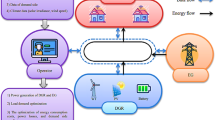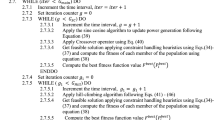Abstract
Energy providers are faced with the challenge of effectively managing electrical energy systems amidst uncertainties. This study focuses on the management and dispatch of energy demand in the electricity microgrid, employing an interval optimization strategy to address electricity price uncertainties. The demand response program (DRP) incentive modeling is utilized to implement demand dispatch. To mitigate the impact of electricity price uncertainties, an incentive modeling approach based on offering reduced electricity demand during peak periods is proposed. The interval optimization approach is employed to minimize operational costs, with the epsilon constraint-based fuzzy method utilized to solve and address the problem. The effectiveness of the proposed modeling approach under conditions of uncertainty is demonstrated through the use of the microgrid in various case studies and numeric simulations. The participation of the DRP leads to minimizing the average and deviation costs by 9.5% and 6.5% in comparison with non-participation.










Similar content being viewed by others
Availability of Data and Materials
The data that support the findings of this study are available from the corresponding author upon reasonable request.
Abbreviations
- t, T :
-
Time (hour)
- m, M :
-
Micro turbine (MT) index (–)
- NC :
-
Consumers’ number
- D eq , D RE :
-
Consumers’ demand and demand reduced by DRP (kW)
- Ψ RE :
-
Offer price for DRP ($)
- C RE :
-
DRP price ($)
- A, B, C :
-
MT fuel cost ($)
- P m , P PM :
-
MT power and PM power (kW)
- c PM :
-
Price of electricity in PM ($)
- Θ RE :
-
Binary variable of the DRP
- τ RE , κ RE :
-
Binary variable for before and after DRP
References
Han L, Yu HH (2023) An empirical study from Chinese energy firms on the relationship between executive compensation and corporate performance. Nurture 17(3):378–393. https://doi.org/10.55951/nurture.v17i3.356
Rehan R (2022) Investigating the capital structure determinants of energy firms. Edelweiss Appl Sci Technol 6(1):1–14. https://doi.org/10.55214/25768484.v6i1.301
Tolmachev Y, Starodubceva SV (2022) Flow batteries with solid energy boosters. J Electrochem Sci Eng 12(4):731–766. https://doi.org/10.5599/jese.1363
Norouzi N, Bozorgian A (2023) Energy and exergy analysis and optimization of a pentageneration (cooling, heating, power, water and hydrogen). Iran J Chem Chem Eng. https://doi.org/10.30492/ijcce.2023.560423.5529
Aalami H, Moghaddam M, Yousefi G (2010) Demand response modeling considering interruptible/curtailable loads and capacity market programs. Appl Energy 87(1):243–250
Chamandoust H et al (2022) Optimal hybrid participation of customers in a smart micro grid based on day ahead electrical market. Artif Intell Rev 55:5891–5915. https://doi.org/10.1007/s10462-022-10154-z
Aikhuele D (2023) Development of a statistical reliability-based model for the estimation and optimization of a spur gear system. J Comput Cogn Eng 2(2):168–174. https://doi.org/10.47852/bonviewJCCE2202153
Chugo D, Muramatsu S, Yokota S, She JH, Hashimoto H (2022) Stand-up assistive devices allowing patients to perform voluntary movements within the safety movement tolerance. J Artif Intell Technol 2(4):164–173
Siano P (2014) Demand response and smart grids-a survey. Renew Sustain Energy Rev 30:461–478
Chen H, Wu H, Kan T, Zhang J, Li H (2023) Low-carbon economic dispatch of integrated energy system containing electric hydrogen production based on VMD-GRU short-term wind power prediction. Int J Electr Power Energy Syst 154:109420. https://doi.org/10.1016/j.ijepes.2023.109420
Qi H et al (2021) Optimisation of a smart energy hub with integration of combined heat and power, demand side response and energy storage. Energy 234:121268
Bakis R, Koc C, Bayazit Y, Cabuk SN (2020) Application of geographic information system to select dam location for hydropower. Int J Sustain Energy Environ Res 9(1):56–72
Ajam M, Mohammadiun H, Dibaee Bonab MH, Mohammadiun M (2022) Energy, exergy, and economic analyses of a combined heat and power generation system with a gas turbine and a horizontal axis wind turbine. Iran J Chem Chem Eng 41(6):2100–2120
Lak Kamari M, Isvand H, Alhuyi Nazari M (2020) Applications of multi-criteria decision-making (MCDM) methods in renewable energy development: a review. Renew Energy Res Appl 1(1):47–54
Zhang L, Sun C, Cai G, Koh LH (2023) Charging and discharging optimization strategy for electric vehicles considering elasticity demand response. eTransportation 18:100262. https://doi.org/10.1016/j.etran.2023.100262
Morales-España G, Martínez-Gordón R, Sijm J (2022) Classifying and modelling demand response in power systems. Energy 242:122544. https://doi.org/10.1016/j.energy.2021.122544
Shen L, Li Z, Sun Y (2016) Performance evaluation of conventional demand response at building-group-level under different electricity pricings. Energy Build 128:143–154. https://doi.org/10.1016/j.enbuild.2016.06.082
Nezhadkian M et al (2023) A model for new product development in business companies based on grounded theory approach and fuzzy method. J Comput Cogn Eng 2(2):124–132. https://doi.org/10.47852/bonviewJCCE2202260
Jiang J, Zhang L, Wen X, Valipour E, Nojavan S (2022) Risk-based performance of power-to-gas storage technology integrated with energy hub system regarding downside risk constrained approach. Int J Hydrogen Energy 47(93):39429–39442. https://doi.org/10.1016/j.ijhydene.2022.09.115
Okampo EJ, Nwulu N (2021) Techno-economic evaluation of reverse osmosis desalination system considering emission cost and demand response. Sustain Energy Technol Assess 46:101252. https://doi.org/10.1016/j.seta.2021.101252
Chen L, Tang H, Wu J, Li C, Wang Y (2022) A robust optimization framework for energy management of CCHP users with integrated demand response in electricity market. Int J Electr Power Energy Syst 141:108181. https://doi.org/10.1016/j.ijepes.2022.108181
Torriti J, Hassan MG, Leach M (2010) Demand response experience in Europe: policies, programmes and implementation. Energy 35:1575–1583. https://doi.org/10.1016/j.energy.2009.05.021
Nawaz A, Zhou M, Wu J, Long C (2022) A comprehensive review on energy management, demand response, and coordination schemes utilization in multi-microgrids network. Appl Energy 323:119596. https://doi.org/10.1016/j.apenergy.2022.119596
O׳Connell N, Pinson P, Madsen H, O׳Malley M (2014) Benefits and challenges of electrical demand response: a critical review. Renew Sustain Energy Rev 39:686–699. https://doi.org/10.1016/j.rser.2014.07.098
Mittelviefhaus M et al (2021) Optimal investment and scheduling of residential multi-energy systems including electric mobility: a cost-effective approach to climate change mitigation. Appl Energy 301:117445
Ghilardi LM et al (2021) Co-optimization of multi-energy system operation, district heating/cooling network and thermal comfort management for buildings. Appl Energy 302:117480
Gholinejad HR et al (2020) A hierarchical energy management system for multiple home energy hubs in neighborhood grids. J Build Eng 28:101028
Bai L, Li F, Cui H, Jiang T, Sun H, Zhu J (2016) Interval optimization based operating strategy for gas-electricity integrated energy systems considering demand response and wind uncertainty. Appl Energy 167:270–279
Chamandoust H et al (2020) Multi-objective operation of smart stand-alone microgrid with the optimal performance of customers to improve economic and technical indices. J Energy Storage 31:101738
Cao B, Dong W, Lv Z, Gu Y, Singh S, Kumar P (2020) Hybrid microgrid many-objective sizing optimization with fuzzy decision. IEEE Trans Fuzzy Syst 28(11):2702–2710. https://doi.org/10.1109/TFUZZ.2020.3026140
Chamandoust H et al (2021) Energy management of a smart autonomous electrical grid with a hydrogen storage system. Int J Hydrogen Energy 46(34):17608–17626
Mirjalili S, Lewis A (2015) Novel performance metrics for robust multi-objective optimization algorithms. Swarm Evol Comput 21:1–23
Chamandoust H et al (2017) Optimal hybrid system design based on renewable energy resources. Proceedings of the IEEE Smart Grid Conference (SGC). https://doi.org/10.1109/SGC.2017.8308878
Author information
Authors and Affiliations
Contributions
All authors have equal contributions including conceptualization, methodology, software, data curation, formal analysis, writing—review and editing, and writing—original draft.
Corresponding author
Ethics declarations
Ethics Approval and Consent to Participate
There are no human subjects in this manuscript and informed consent is not applicable.
Competing Interests
The authors declare no competing interests.
Additional information
This article is part of the Topical Collection on Mathematical Models and Optimization for Environmental Engineering and Sustainable Technologies
Rights and permissions
Springer Nature or its licensor (e.g. a society or other partner) holds exclusive rights to this article under a publishing agreement with the author(s) or other rightsholder(s); author self-archiving of the accepted manuscript version of this article is solely governed by the terms of such publishing agreement and applicable law.
About this article
Cite this article
Mamani, J.C.M., Carrasco-Choque, F., Paredes-Calatayud, E.F. et al. Modeling Uncertainty Energy Price Based on Interval Optimization and Energy Management in the Electrical Grid. Oper. Res. Forum 5, 4 (2024). https://doi.org/10.1007/s43069-023-00289-2
Received:
Accepted:
Published:
DOI: https://doi.org/10.1007/s43069-023-00289-2




